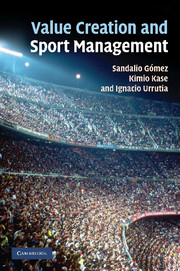Book contents
- Frontmatter
- Dedication
- Contents
- List of figures
- List of tables
- List of contributing authors
- Foreword
- Introduction
- 1 The virtuous circle of value creation in the sports industry
- 2 Value creation and performance criteria for sport entities
- 3 National context and profit strategy of the sport entity
- 4 Value creation in two of the most prestigious Spanish football clubs
- 5 The proto-image of Real Madrid
- 6 Value creation from the organizational structure of a sports entity
- Appendix I Why NGOs matter for the success of sporting events
- Appendix II Strategic evaluation of sponsorship and patronage
- Appendix III Structural characteristics of sport organizations
- Index
- References
Appendix III - Structural characteristics of sport organizations
main trends in the academic discussion
Published online by Cambridge University Press: 05 February 2014
- Frontmatter
- Dedication
- Contents
- List of figures
- List of tables
- List of contributing authors
- Foreword
- Introduction
- 1 The virtuous circle of value creation in the sports industry
- 2 Value creation and performance criteria for sport entities
- 3 National context and profit strategy of the sport entity
- 4 Value creation in two of the most prestigious Spanish football clubs
- 5 The proto-image of Real Madrid
- 6 Value creation from the organizational structure of a sports entity
- Appendix I Why NGOs matter for the success of sporting events
- Appendix II Strategic evaluation of sponsorship and patronage
- Appendix III Structural characteristics of sport organizations
- Index
- References
Summary
Introduction
This appendix complements the analysis on the relations between the performance and organizational structure and focuses on the characteristics of structures. Its main purpose is the review of the existing literature on the topic.
There exists an abundant literature on organizational structure from 1950 onwards. There is Mintzberg's work on typologies of organization based on different structural designs (Mintzberg, 1979), Burns and Stalker's types of organizational structure according to different environmental conditions (Burns and Stalker, 1961), Child's structuring of activities inside the organization (Child, 1972) and Miles and Snow's conception of structure based on the strategy of the organization (Miles and Snow, 1978), among many others. The interest in studying organizational structure resides in the relationship between organizational design and other organizational phenomena, like performance, distribution of power, or control systems. While there is plenty of literature on organizational structure studying different types of organizations, little is written on the specific field of sport organizations in books and journals.
Some authors have used sports as a context for illustrating organizational phenomenon like organizational loyalty, performance, compensation system, escalating commitment, executive succession, sustainable competitive advantage and human resources, among others. Although research on the particular nature of sport organizations and their structural characteristics is still scarce, the article ‘Sport and Organizational Studies: Exploring Synergies’ (Wolfe et al., 2005) presents a literature review in which they cover a broad spectrum of research studying organizational phenomena in the context of sports.
- Type
- Chapter
- Information
- Value Creation and Sport Management , pp. 229 - 261Publisher: Cambridge University PressPrint publication year: 2010



